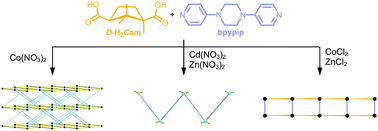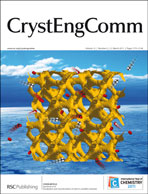Homochiral transition-metal camphorate coordination architectures containing “piperazine–pyridine” ligands†
Abstract
A total of five homochiral metal–organic coordination ![[double bond, length as m-dash]](https://www.rsc.org/images/entities/char_e001.gif) O)OH⋯O(carboxylate) hydrogen bonds, the zigzag coordination-chain becomes extended to a three-dimensional uninodal 6-connected supramolecular network, which can be considered as a result of a M–D-HCam-based 4-connected supramolecular 65·8-net intersected by M–bpypip-based zigzag coordination-chains. Of particular interest, the supramolecular assembly contains a couple of single-stranded right- (SRH) and left-handed (SLH) supramolecular helices and a couple of double-stranded right- (DRH) and left-handed (DLH) supramolecular helices, and therefore exists as a meso-net in topology, i.e., there is no spatial chirality. Compounds [M2(OH)(OAc)(D-Cam)(bpypip)] (4, M = Co; 5, M = Zn) have identically homochiral ladder-like chain structures having meso-M2 units and presenting three kinds of different anions, i.e.,
O)OH⋯O(carboxylate) hydrogen bonds, the zigzag coordination-chain becomes extended to a three-dimensional uninodal 6-connected supramolecular network, which can be considered as a result of a M–D-HCam-based 4-connected supramolecular 65·8-net intersected by M–bpypip-based zigzag coordination-chains. Of particular interest, the supramolecular assembly contains a couple of single-stranded right- (SRH) and left-handed (SLH) supramolecular helices and a couple of double-stranded right- (DRH) and left-handed (DLH) supramolecular helices, and therefore exists as a meso-net in topology, i.e., there is no spatial chirality. Compounds [M2(OH)(OAc)(D-Cam)(bpypip)] (4, M = Co; 5, M = Zn) have identically homochiral ladder-like chain structures having meso-M2 units and presenting three kinds of different anions, i.e.,


 Please wait while we load your content...
Please wait while we load your content...